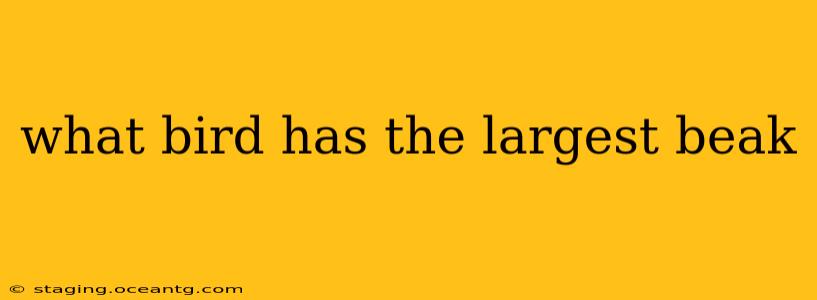The title itself hints at a fascinating question within the avian world: beak size and its relation to survival. While pinpointing the single bird with the "absolutely largest" beak is tricky due to variations in beak measurement (length, width, weight, etc.) and the sheer diversity of bird species, we can explore some strong contenders and the factors influencing beak size. This exploration will delve into the amazing adaptations of birds and the intricate relationship between beak morphology and their ecological niche.
What are some of the largest beaks in the bird world?
Several bird species boast impressively large beaks, each adapted to its specific feeding strategy. Let's examine a few:
-
The Toco Toucan: Often cited as having one of the largest beaks relative to its body size, the Toco Toucan's beak is a striking feature. Its massive beak, although seemingly cumbersome, is surprisingly lightweight due to its spongy internal structure. This structure isn't just for show; it plays a crucial role in thermoregulation and possibly even communication.
-
The Hornbill: Various hornbill species showcase impressively large and often brightly colored beaks. These beaks aren't just for show; their size and shape are essential for foraging, particularly for cracking tough nuts and seeds. Different hornbill species have evolved beak variations reflecting their dietary needs and habitat.
-
The Shoebill: This unusual bird's name perfectly describes its beak. Resembling a clunky shoe, the Shoebill's beak is broad, powerful, and designed for catching fish and other aquatic prey. Its massive size enables it to efficiently hunt in its swampy habitat.
-
The African Grey Parrot: While not as visually striking as some others on this list, the African Grey Parrot possesses a remarkably large and powerful beak that is perfectly adapted for cracking nuts and seeds. Their beak strength is directly linked to their diet and survival in their native African forests.
How is beak size related to a bird's diet?
A bird's beak size is intimately linked to its diet and foraging strategies. The size, shape, and strength of the beak are crucial adaptations for accessing and consuming food. Birds with large beaks are often specialized to consume large or hard items:
- Large, strong beaks: Ideal for cracking tough seeds, nuts, or shells.
- Long, slender beaks: Perfect for probing into flowers for nectar or picking insects from crevices.
- Large, hooked beaks: Excellent for tearing flesh, as seen in raptors.
What determines the size of a bird’s beak?
Multiple factors determine a bird's beak size:
- Diet: This is arguably the most important factor. A diet rich in hard-to-crack items necessitates a larger, stronger beak.
- Habitat: The environment in which a bird lives shapes its beak adaptations. For instance, birds living in areas with abundant tough-shelled seeds will likely develop larger beaks.
- Genetics: Genetic inheritance plays a significant role in beak size and shape, passing down advantageous traits over generations.
- Sexual selection: In some species, beak size contributes to sexual attractiveness, influencing mate selection and ultimately affecting beak size evolution within the population.
What is the difference between a beak and a bill?
The terms "beak" and "bill" are often used interchangeably, referring to the external structure of a bird's mouth. There isn't a strict biological difference between the two terms.
Which bird has the longest beak?
While the Toco Toucan often gets the spotlight, definitively stating which bird has the longest beak requires careful consideration of different measurement techniques and the potential for undiscovered species. Accurate comparative data across all bird species is lacking.
In conclusion, while a single definitive answer to "What bird has the largest beak?" remains elusive due to the complexities of beak measurement and the incredible diversity within the avian world, this exploration highlights the remarkable adaptations of various species and the intimate connection between beak morphology, diet, and survival. Further research and comparative studies are needed to provide a more precise answer, but the journey of discovering the amazing diversity of bird beaks is itself a fascinating endeavor.
